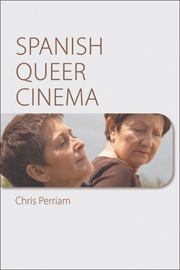Introduction
Published online by Cambridge University Press: 05 August 2013
Summary
Contents
This book is an analysis of the development of Lesbian Gay Bisexual Trans and Queer (LGBTQ) culture and film-making and film-watching in Spain from the end of the 1990s onwards. There are two reasons for the chosen period of coverage. Firstly, the 1990s were years of rising recognition for lesbian and gay, and New Queer, cinema worldwide, and Spain by the end of the decade had joined in; furthermore, 1998 was the year in which the Catalan government passed the first of a series of regional government laws in Spain on civil union, marking a substantial increase in the intensity and visibility of discourses -verbal and visual or performed – around LGBTQ identities. Changes to the Spanish Civil Code were, famously, passed into law in July 2005, providing ‘access for same-sex married couples to rights of inheritance, residence, adoption of the other spouse's children, tax benefits, and to divorce rights’ (Platero Méndez 2007b: 335). This sequence of surface events, with profound social and personal implications, created a ripple effect in the politics of the everyday and in the cultural expression and production of LGBTQ Spain: unsurprisingly, the effect is felt and amplified in some films, or tellingly ignored or simplified in others. Chapter 1 links its discussion of ‘queer’ to this phenomenon of liberalisation in terms of rights, and takes into account the clashes and exchanges between ‘gay’, ‘queer’ and ‘lesbian’ cultures, and how these inform the notion of a Spanish queer cinema. Chapter 1, then, is concerned with post-identity politics modes of being as well as of post-gay lifestyle ways of behaving in community.
- Type
- Chapter
- Information
- Spanish Queer Cinema , pp. 1 - 8Publisher: Edinburgh University PressPrint publication year: 2012



